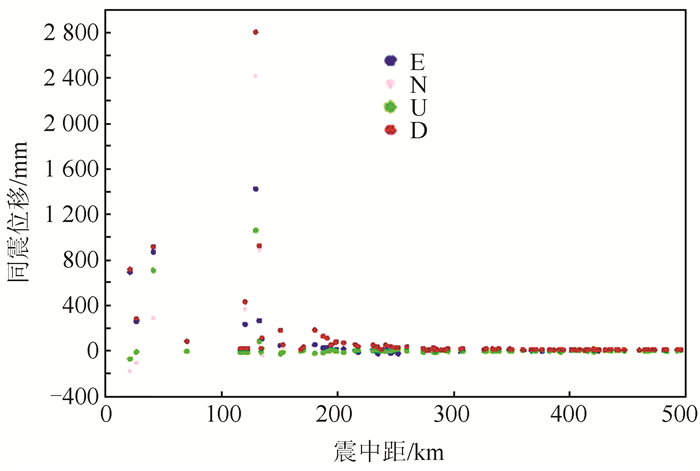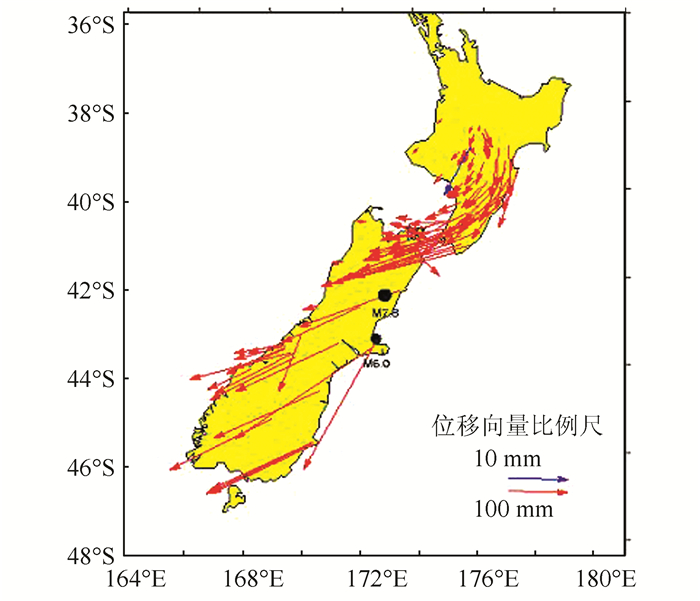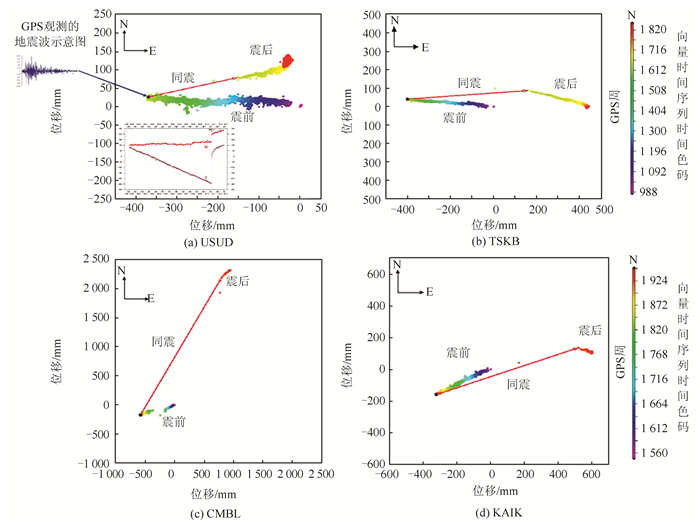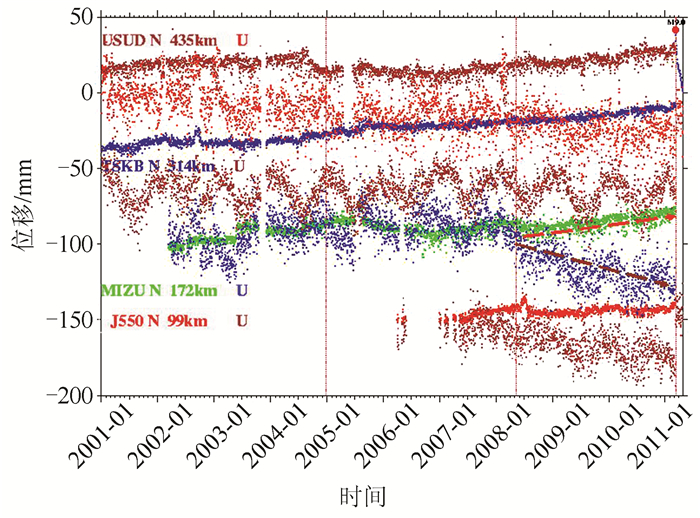Results of GPS Observations for M7.8 Earthquake in 2016 in New Zealand and Discussion on Elastic Rebound Model
-
摘要: 利用http://geodesy.unr.edu网站发布的新西兰和澳大利亚部分GPS连续观测站的数据处理结果,获取2016-11-13新西兰7.8级大地震同震位移、区域参考框架震前和震后水平位移。新西兰CMBL和KAIK站及日本USUD和TSKB等站的水平位移向量时间序列图直观且清楚地显示,同一GPS站同震水平位移方向和震前积累水平位移的总方向相反,同震水平位移是震前积累的水平位移的回跳或弹性回跳,因此,震前积累的水平位移是地震前兆。利用丰富的GPS观测结果讨论回跳或弹性回跳模型。分析东日本9.0级大地震GPS观测结果,表明,震前震中区一主应变为东西向的压缩,而地震的发生和同震形变是地震断层剪切形变所致。这与岩石破裂实验、应变理论和地震机制研究结果一致。
-
关键词:
- GPS /
- 同震位移 /
- 水平位移向量 /
- 2016年新西兰7.8级大地震 /
- 弹性回跳
Abstract: the coseismic and the preseismic displacements in the regional reference frame were obtained for the M7.8 earthquake on Nov. 13, 2016 in New Zealand based on time series of coordinates at continuous GPS observation stations, available from http://geodesy.unr.edu, in New Zealand and Australia. horizontal displacement time series vectors at CMBL and KAIK in New Zealand and at USUD and TSKB in Japan are shown. The vector time series show clearly with direct visual effect that the coseismic horizontal displacements were sudden and dramatic, and opposite to the accumulated preseismic horizontal displacements. These represent a rebound or elastic rebound of the accumulated preseismic horizontal displacements. Therefore, the accumulated preseismic horizontal displacements were precursors to the earthquakes. Results produced from the abundant GPS observations are used to discuss the rebound and elastic rebound models. Detailed reanalysis on the results of GPS observations of the M9.0 Tohoku earthquake in Japan shows that one principal strain in the region at and around the epicenter was dominated by compression in the east direction before the earthquake. Moreover, the earthquake and the coseismic displacements were the result of shear rupture at the earthquake faults. This agrees with test of rock failure results, strain analysis, and consistent with earthquake mechanisms. -
-
-
[1] 顾国华. GPS:地震预测利器[M].北京:北京大学出版社, 2012 Gu Guohua. GPS:Useful Technique for Earthquake Prediction[M]. Beijing:Publishing House of the Peking University, 2012
[2] Gu Guohua, Wang Wuxing. Advantages of GNSS in Monitoring Crustal Deformation for Detection of Precursors to Strong Earthquakes[J]. Positioning, 2013(4):11-19 http://d.wanfangdata.com.cn/OAPaper/oai_doaj-articles_2193498891aa4b0a2784abfdfb2b4bc3
[3] 顾国华, 王武星, 孟国杰, 等. GPS测得的汶川大地震前后的地壳运动[J].武汉大学学报·信息科学版, 2009, 34(11):1336-1339 http://ch.whu.edu.cn/CN/abstract/abstract1443.shtml Gu Guohua, Wang Wuxing, Meng Guojie, et al. Crustal Movements Before and After the Great Wenchuan Earthquake Observed by GPS[J]. Geomatics and Information Science of Wuhan University, 2009, 34(11):1336-1339 http://ch.whu.edu.cn/CN/abstract/abstract1443.shtml
[4] Gu Guohua, Wang Wuxing, Xu Yueren, et al. Horizontal Crustal Movement Before the Great Wenchuan Earthquake Obtained from GPS Observations in the Regional Network[J]. Earthquake Science, 2009, 22(5):471-478 doi: 10.1007/s11589-009-0471-x
[5] Gu Guohua, Meng Guojie, Wang Wuxing. Anomalous Crustal Movements Before the Great Wenchuan Earthquake Obtained from GPS Observations[J]. Geodesy and Geodynamics, 2011, 2(2):13-22 doi: 10.3724/SP.J.1246.2011.00013.1
[6] Gu Guohua, Wang Wuxing. Far-Field Crustal Movements Before and After the 2011 Ms 9.0 Japan Earthquake from GPS Observations[J]. Geodesy and Geodynamics, 2011, 2(3):1-7 doi: 10.3724/SP.J.1246.2011.00001.2
[7] 顾国华, 王武星, 占伟, 等.东日本Mw 9.0大地震前、同震及震后地壳水平运动[J].武汉大学学报·信息科学版, 2015, 40(12):1669-1676 http://ch.whu.edu.cn/CN/abstract/abstract3397.shtml Gu Guohua, Wang Wuxing, Zhan Wei, et al. Preseismic, Coseismic and Postseismic Horizontal Crustal Movements of the M9.0 Tohoku Earthquake in 2011 in Japan[J]. Geomatics and Information Science of Wuhan University, 2015, 40(12):1669-1676 http://ch.whu.edu.cn/CN/abstract/abstract3397.shtml
[8] 顾国华, 王武星, 占伟, 等.芦山Ms 7.0大地震前和同震水平位移[J].地震学报, 2015, 37(1):54-65 Gu Guohua, Wang Wuxing, Zhan Wei, et al. Preseismic and Coseismic Horizontal Crustal Movements of the Ms 7.0 Lushan Earthquake on April 20, 2013 in Sichuan[J]. Acta Seismologica Sinica, 2015, 37(1):54-65
[9] 顾国华.2016年4月16日日本九州岛M7.3级大地震前及同震地壳运动[J].地震, 2017, 37(3):28-37 Gu Guohua. Preseismic and Coseismic Crustal Movements of the M7.3 Kyushu Earthquake on April 16, 2016 in Japan[J]. Earthquake, 2017, 37(3):28-37
[10] Blewitt G, Kreemer C, Hammond W C, et al. Deformation Studies in North America[J]. Journal of Geodynamics, 2013(72):11-24 http://d.wanfangdata.com.cn/Conference/8633148
[11] Gu Guohua, Shen Xuhui, Wang Min, et al. General Characteristcs of the Recent Horizontal Crustal Movement in Chinese Mainland[J]. Acta Seismologica Sinica, 2001, 14(4):384-393 doi: 10.1007/s11589-001-0116-1
[12] Gu Guohua, Fu Yang, Wang Wuxing. Horizontal Crustal Movement in Chinese Mainland from 1999 to 2001[J]. Acta Seismologica Sinica, 2004, 17(Supp.):53-60
[13] Kreemer C, Blewitt G, Hammond W C, et al. Global Deformation from the Great 2004 Sumatra-Andaman Earthquake Observed by GPS:Implications for Rupture Process and Global Reference Frame[J]. Earth Planets Space, 2006, 58:141-148 doi: 10.1186/BF03353370
[14] 顾国华, 张晶, 王武星.中国地壳运动观测网络基准站水平位移向量时间序列[J].地震, 2003, 23(2):39-47 http://d.wanfangdata.com.cn/Periodical/diz200302005 Gu Guohua, Zhang Jing, Wang Wuxing. Time Series of Horizontal Displacement Vectors Obtained at Fiducial Stations in the Crustal Movement Observations of China[J].Earthquake, 23(2):39-47 http://d.wanfangdata.com.cn/Periodical/diz200302005
[15] Wang W, Sun W, Wu Y, et al. Modification of Fault Slip Models of the Mw 9.0 Tohoku Earthquake by Far Field GPS Observations[J].Journal of Geodynamics, 2014, 75:22-33 doi: 10.1016/j.jog.2014.01.005
[16] Iinuma T. Coseismic Slip Distribution of the 2011 off the Pacific Coast of Tohoku Earthquake (M9.0) Refined by Means of Seafloor Geodetic Data[J]. J Geophys Res, 2012, DOI: 10.1029/2012JB009186
[17] Shinzaburo O, Takuya N, Hiroshi M, et al. Preceding, Coseismic, and Postseismic Slips of the 2011 Tohoku Earthquake, Japan[J]. Journal of Geophysical Research, 2012, 117, DOI: 10.1029/2011JB009120





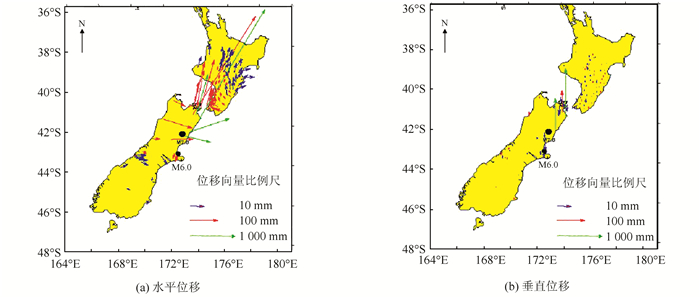
 下载:
下载:
